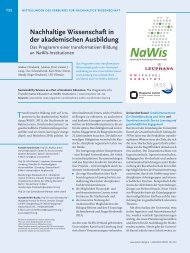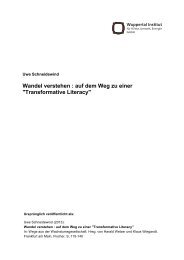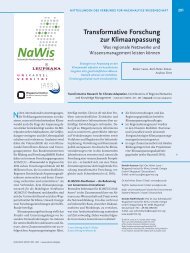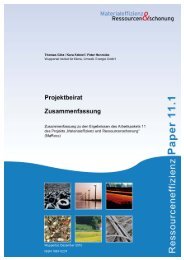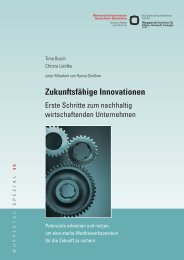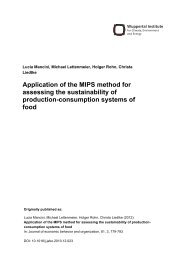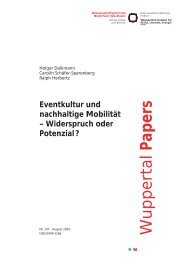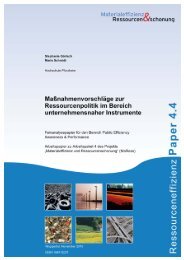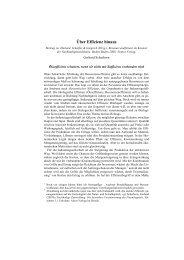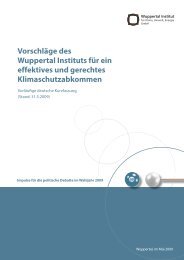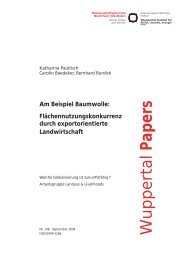Resource Efficiency Atlas - Publication Server of the Wuppertal ...
Resource Efficiency Atlas - Publication Server of the Wuppertal ...
Resource Efficiency Atlas - Publication Server of the Wuppertal ...
You also want an ePaper? Increase the reach of your titles
YUMPU automatically turns print PDFs into web optimized ePapers that Google loves.
52<br />
Examples for resource efficiency | Products | Food<br />
Products<br />
Textiles IT and Communication Food Transport and Traffic Buildings and Housing Optics<br />
A new method <strong>of</strong> blanching potatoes saves energy and wastewater<br />
Eco-friendly potato processing<br />
A key process in potato processing is blanching. Blanching can be run in a closed system where<br />
<strong>the</strong> loss <strong>of</strong> freshwater, wastewater, energy and vital ingredients can be reduced.<br />
Fermenter (Source: Aviko Holding)<br />
During <strong>the</strong> blanching process food is dipped into boiling<br />
water for a short period <strong>of</strong> time, mostly 10 to 30 seconds.<br />
This process is particularly applicable for vegetables and<br />
mushrooms. Potatoes are blanched, for example, before<br />
freezing different kinds <strong>of</strong> potato-products. It helps to<br />
prevent undesirable changes like enzymatic browning<br />
or <strong>the</strong> degradation <strong>of</strong> valuable ingredients and, <strong>the</strong>reby,<br />
a large amount <strong>of</strong> scrap by deactivating <strong>the</strong> enzymes.<br />
Ressourceneffizienzatlas<br />
<strong>Resource</strong> <strong>Efficiency</strong> <strong>Atlas</strong><br />
Fur<strong>the</strong>rmore, <strong>the</strong> natural level <strong>of</strong> sugar in potatoes can be<br />
reduced. However, essential ingredients such as minerals or<br />
amino acids are being leached out <strong>of</strong> <strong>the</strong> potatoes. Studies<br />
have shown that <strong>the</strong> loss <strong>of</strong> <strong>the</strong>se essential ingredients<br />
during <strong>the</strong> blanching process can be prevented if <strong>the</strong> defined<br />
concentration <strong>of</strong> minerals and amino acids in <strong>the</strong> hot<br />
process water is set correctly.<br />
In order to remove sugar from <strong>the</strong> hot process water after<br />
<strong>the</strong> blanching process, <strong>the</strong> Dutch company Aviko uses a<br />
fermenter. Thus, <strong>the</strong> hot water has a lower concentration<br />
<strong>of</strong> sugar and it can be used for a fur<strong>the</strong>r blanching process.<br />
Due to <strong>the</strong> repeated different sugar concentration levels<br />
within <strong>the</strong> potato and <strong>the</strong> process water, leaching <strong>of</strong> sugar<br />
from <strong>the</strong> potato occurs while concentration <strong>of</strong> essential ingredients<br />
is reliable. This process is also called “Closed-Loop<br />
Blanching” (CLB).<br />
With CLB technology it is possible to recycle most <strong>of</strong> <strong>the</strong><br />
process water and reduce energy consumption during potato<br />
processing. This is because <strong>the</strong> recycled water requires<br />
significantly less heat to achieve <strong>the</strong> required process temperature.<br />
Aviko has patented this technology.



